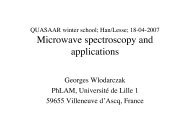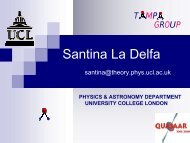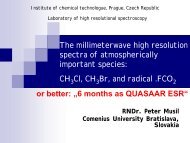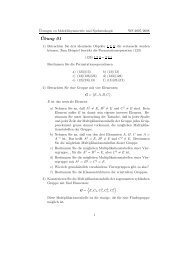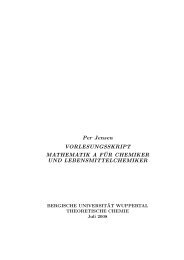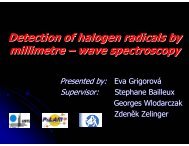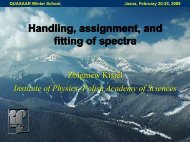60 Poster session, D13Frequency analysis of the 10 and 3 μm regions of theethylene spectrum using the D 2h Top Data SystemMarie-Thérèse Bourgeois, 1 Maud Rotger, 1 Vincent Boudon, 2Jean Vander Auwera 31 Groupe de Spectrométrie Moléculaire et Atmosphérique, UMR CNRS 7331,Université de Reims, Moulin de la Housse, BP 1039, F-51687 Reims Cedex, France,maud.rotger@univ-reims.fr;2Laboratoire Interdisciplinaire Carnot de Bourgogne, CNRS UMR 6303, 9 avenue A.Savary, BP 47 870, F-21000 Dijon Cedex, France, vincent.boudon@u-bourgogne.fr;3Service de Chimie Quantique et <strong>Ph</strong>otophysique, C.P. 160/09, Université Libre deBruxelles, 50 avenue F.D. Roosevelt, B-1050 Brussels, Belgium, jauwera@ulb.ac.beBourgeois M.-T.Rotger M.Boudon V.Vander AuweraWe developed a tensorial formalism adapted to X 2 Y 4 planar asymmetric tops with D 2hsymmetry [1], and proposed a program suite called D 2h TDS [2] to calculate their highresolutionspectra. This approach has the advantages to allow a systematic developmentof rovibrational interactions and to make global, polyad-by-polyad analyses easier toperform. With such theoretical means, we aim to describe globally the first two lowenergy spectral regions of ethylene ( 12 C 2 H 4 ).Following our work devoted to the ν 12 band [3], we use D 2h TDS to perform a frequencyre-analysis of the ν 10 /ν 7 /ν 4 /ν 12 infrared tetrad in the 800 – 1500 cm –1 region (see [4] fora review of the extensive studies devoted to this region). We also apply D 2h TDS to theanalysis of the complex 3 μm region, corresponding to the excitation of the ν 9 (at 3106cm –1 ) and ν 11 (at 2989 cm –1 ) modes, the upper states of which being Coriolis-coupled tomany vibrational combination states [5]. These studies rely on high-resolution Fouriertransform spectra that we recorded in both spectral ranges. Results of this ongoing workwill be presented and discussed.References[1] W. Raballand, M. Rotger, V. Boudon, M. Loëte, J. Mol. Spectrosc. 217, 239, 2003.[2] C. Wenger, W. Raballand, M. Rotger, V. Boudon, J. Quant. Spectrosc. Radiat.Transfer 95, 521, 2005.[3] M. Rotger, V. Boudon, J. Vander Auwera, J. Quant. Spectrosc. Radiat. Transfer109, 952, 2008.[4] E. Rusinek, H. Fichoux, M. Khelkhal, F. Herlemont, J. Legrand, A. Fayt, J. Mol.Spectrosc. 189, 64, 1998.[5] B.G. Sartakov, J. Oomens, J. Reuss, A. Fayt, J. Mol. Spectrosc. 185, 31, 1997.AcknowledgmentsJVDA acknowledges financial support from the Fonds de la Recherche Scientifique (F.R.S.-FNRS, Belgium, contract FRFC), the Action de Recherches Concertées of the Communautéfrançaise de Belgique, and the Belgian Federal Science Policy Office (contract SD/CS/07A,Advanced Exploitation of Ground-Based Measurements for Atmospheric Chemistry andClimate applications – II).
Poster session, D14 61A new analysis of the ν 7 band of ethaneMarcela Tudorie, 1 Carlo di Lauro, 2 Franca Lattanzi, 2 Jean Vander Auwera 11 Service de Chimie Quantique et <strong>Ph</strong>otophysique, C.P. 160/09, Université Libre deBruxelles, 50 avenue F.D. Roosevelt, B-1050 Brussels, Belgium, jauwera@ulb.ac.be;2 Chimica Fisica, Università di Napoli Federico II, 49 via D. Montesano, I-80131 Napoli,Italy, car.dilauro@gmail.comTudorie M.Di Lauro C.Lattanzi F.Vander AuweraEthane is a prolate symmetric top involving two coaxial identical internal rotors. Its fiveinfrared active fundamental transitions define 3 main spectral regions, around 12, 6.2–7.5 and 3.3 µm, all of interest for remote sensing measurements. In this context, the CHstretching fundamental band ν 7 near 2985 cm –1 is particularly useful because it exhibitsa series of very strong Q-branches that can provide a sensitive detection of C 2H 6. 1,2Unfortunately, this spectral region is complex and difficult to model. 3,4The present work builds upon the recent contributions by Lattanzi et al 3 and Villanuevaet al. 4 We rely on high-resolution Fourier transform spectra recorded in our laboratoryand on previous assignments. 3,5,6 Because of the complexity of the energy levelsstructure at 3.3 µm, we treat each K sub-band separately, an approach similar toprevious work. 4-6 The description of perturbations given in Ref. 3 was found to beparticularly helpful to assign higher J and K lines. The latest results will be presented.References[1] A.S. Pine, C.P. Rinsland, J. Quant. Spectrosc. Radiat. Transfer 62, 445, 1999.[2] K. Magee-Sauer, M.J. Mumma, M.A. DiSanti, N. Dello Russo, E.L. Gibb, B.P.Boney, G.L. Villanueva, Icarus 194, 347, 2008.[3] F. Lattanzi, C. di Lauro, J. Vander Auwera, J. Mol. Spectrosc. 267, 71, 2011.[4] G. L. Villanueva, M. J. Mumma, K. Magee-Sauer, J. Geophys. Res. 116, E08012,2011.[5] A.S. Pine, W.J. Lafferty, J. Res. Natl. Bur. Stand. 87, 237, 1982.[6] A.S. Pine and S.C. Stone, J. Mol. Spectrosc. 175, 21, 1996.AcknowledgmentsThe authors thank M. Herman for making his jet-cooled spectra of ethane available.Financial support from the Fonds de la Recherche Scientifique (F.R.S.-FNRS, Belgium,contract FRFC), the Action de Recherches Concertées of the Communauté française deBelgique, and the Belgian Federal Science Policy Office (contract SD/CS/07A,Advanced Exploitation of Ground-Based Measurements for Atmospheric Chemistry andClimate applications – II) is gratefully acknowledged.
- Page 1 and 2:
Book of abstractsof the 22 th Inter
- Page 3 and 4:
CommitteesLocal Organizing committe
- Page 5:
Table of contentProgram of sessions
- Page 8 and 9:
8 Program of sessionsInvited Lectur
- Page 10 and 11: 10 Program of sessionsD6 Tasinato N
- Page 12 and 13: 12 Program of sessionsD23 Underwood
- Page 14 and 15: 14 Program of sessionsD43 Kirkpatri
- Page 16: 16 Program of sessionsG5 Ebert V. 1
- Page 20 and 21: 20 Program of sessionsH36 Vogt N.,
- Page 22 and 23: 22 Program of sessionsJ8 Tudorie M.
- Page 24 and 25: 24 Program of sessionsJ26 Osman O.,
- Page 26 and 27: 26 Program of sessionsIoannes Marcu
- Page 28 and 29: 28 Program of sessionsContributed L
- Page 31 and 32: Invited LecturesASeptember 4, Tuesd
- Page 33: Invited Lectures, A2 33Ultra sensit
- Page 36 and 37: 36 Contributed Lectures, B1Chirped-
- Page 38 and 39: 38 Contributed Lectures, B3Chirped
- Page 40 and 41: 40 Contributed Lectures, B5Laborato
- Page 43 and 44: Invited LecturesCSeptember 4, Tuesd
- Page 45: Invited Lectures, C2 45Chiral recog
- Page 48 and 49: 48 Poster session, D1Spectroscopic
- Page 50 and 51: 50 Poster session, D3Ab-initio norm
- Page 52 and 53: 52 Poster session, D5The 2 and 4
- Page 54 and 55: 54 Poster session, D7IR spectroscop
- Page 56 and 57: 56 Poster session, D9The stretching
- Page 58 and 59: 58 Poster session, D11Rotationally-
- Page 62 and 63: 62 Poster session, D15High-L atomic
- Page 64 and 65: 64 Poster session, D17High-Resoluti
- Page 66 and 67: 66 Poster session, D19Frequency-com
- Page 68 and 69: 68 Poster session, D21Variational c
- Page 70 and 71: 70 Poster session, D23Variationally
- Page 72 and 73: 72 Poster session, D25MOGADOC - A D
- Page 74 and 75: 74 Poster session, D27Theoretical I
- Page 76 and 77: 76 Poster session, D29Spectroscopy
- Page 78 and 79: 78 Poster session, D31Coriolis Anal
- Page 80 and 81: 80 Poster session, D33Symmetric gro
- Page 82 and 83: 82 Poster session, D35Dissociative
- Page 84 and 85: 84 Poster session, D37Absorption sp
- Page 86 and 87: 86 Poster session, D39Low-energy vi
- Page 88 and 89: 88 Poster session, D41New progress
- Page 90 and 91: 90 Poster session, D43High Resoluti
- Page 93 and 94: Invited LecturesESeptember 5, Wedne
- Page 95: Invited Lectures, E2 95Theoretical
- Page 98 and 99: 98 Contributed Lectures, F1On the r
- Page 100 and 101: 100 Contributed Lectures, F3High Re
- Page 102 and 103: 102 Contributed Lectures, F5Large A
- Page 105 and 106: Contributed LecturesGSeptember 5, W
- Page 107 and 108: Contributed Lectures, G2 107Inversi
- Page 109 and 110: Contributed Lectures, G4 109Spontan
- Page 111:
Contributed Lectures, G6 111High te
- Page 114 and 115:
114 Poster session, H1Computation o
- Page 116 and 117:
116 Poster session, H3Rotationally-
- Page 118 and 119:
118 Poster session, H5The Rotationa
- Page 120 and 121:
120 Poster session, H7Laser-Induced
- Page 122 and 123:
122 Poster session, H9High resoluti
- Page 124 and 125:
124 Poster session, H11Structure, U
- Page 126 and 127:
126 Poster session, H13From succini
- Page 128 and 129:
128 Poster session, H15On the “Ex
- Page 130 and 131:
130 Poster session, H17Hyperfine sp
- Page 132 and 133:
132 Poster session, H19The first ro
- Page 134 and 135:
134 Poster session, H21High Resolut
- Page 136 and 137:
136 Poster session, H23Spectroscopy
- Page 138 and 139:
138 Poster session, H25New investig
- Page 140 and 141:
140 Poster session, H27Submillimetr
- Page 142 and 143:
142 Poster session, H29First analys
- Page 144 and 145:
144 Poster session, H31High-Resolut
- Page 146 and 147:
146 Poster session, H33Rotational s
- Page 148 and 149:
148 Poster session, H35New assignme
- Page 150 and 151:
150 Poster session, H37Hydrogen Sul
- Page 152 and 153:
152 Poster session, H39New Millimet
- Page 154 and 155:
154 Poster session, H41First analys
- Page 156 and 157:
156 Poster session, H43High-Resolut
- Page 159 and 160:
Invited LecturesISeptember 6, Thurs
- Page 161:
Invited Lectures, I2 161New Telesco
- Page 164 and 165:
164 Poster session, J1Synthesis, Ch
- Page 166 and 167:
166 Poster session, J3Radio Search
- Page 168 and 169:
168 Poster session, J5N 2 -, O 2 -
- Page 170 and 171:
170 Poster session, J7Quantum-class
- Page 172 and 173:
172 Poster session, J9On the ECS fo
- Page 174 and 175:
174 Poster session, J11Measurement
- Page 176 and 177:
176 Poster session, J13Review of th
- Page 178 and 179:
178 Poster session, J15Halogen bond
- Page 180 and 181:
180 Poster session, J17Multispectru
- Page 182 and 183:
182 Poster session, J19Potential en
- Page 184 and 185:
184 Poster session, J21The Study of
- Page 186 and 187:
186 Poster session, J23Pollutants m
- Page 188 and 189:
188 Poster session, J25Preparation
- Page 190 and 191:
190 Poster session, J27Databases of
- Page 192 and 193:
192 Poster session, J29Ozone FTS sp
- Page 194 and 195:
194 Poster session, J31Joint Ro-Vib
- Page 196 and 197:
196 Poster session, J33Water vapor
- Page 198 and 199:
198 Poster session, J35Line positio
- Page 200 and 201:
200 Poster session, J37Hyperfine St
- Page 202 and 203:
202 Poster session, J39Rotational a
- Page 204 and 205:
204 Poster session, J41Tissue Bondi
- Page 207 and 208:
Ioannes Marcus MarciKSeptember 6, T
- Page 209 and 210:
Invited LecturesLSeptember 7, Frida
- Page 211:
Invited Lectures, L2 211Collision-I
- Page 214 and 215:
214 Contributed Lectures, M1Flexibl
- Page 216 and 217:
216 Contributed Lectures, M3Continu
- Page 218 and 219:
218 Contributed Lectures, M5High-pr
- Page 221 and 222:
Contributed LecturesNSeptember 8, S
- Page 223 and 224:
Contributed Lectures, N2 223Two- di
- Page 225 and 226:
Contributed Lectures, N4 225Spectro
- Page 227 and 228:
Contributed Lectures, N6 227Spin-or
- Page 229 and 230:
Contributed Lectures, N8 229Quantum
- Page 231:
Contributed Lectures, N10 231Line m
- Page 234 and 235:
234 Author indexAAbdelghany A. —
- Page 236 and 237:
236 Author indexChoi B. — D33Ciur
- Page 238 and 239:
238 Author indexGGambi A. — D6Gä
- Page 240 and 241:
240 Author indexKhelkhal M. — D29
- Page 242 and 243:
242 Author indexMartin M.A. — D31
- Page 244 and 245:
244 Author indexPolyansky O. — D2
- Page 246 and 247:
246 Author indexSzajna W. — H29,
- Page 248 and 249:
248 Author indexZamotaeva V.A. —
- Page 250 and 251:
250 EmailsAbdelghany A.Abdelghany A
- Page 252 and 253:
252 EmailsGuarnieri A.ag@tf.uni-kie
- Page 254 and 255:
254 EmailsMichaut X.Xavier.Michaut@
- Page 256 and 257:
256 EmailsTyuterev Vl.G.vladimir.ti
- Page 258 and 259:
FT-IR spectrometerIFS 125HROutstand
- Page 260 and 261:
32nd International Symposium on Fre
- Page 262 and 263:
Some more information
- Page 264:
Addresses:Conference Site: National




